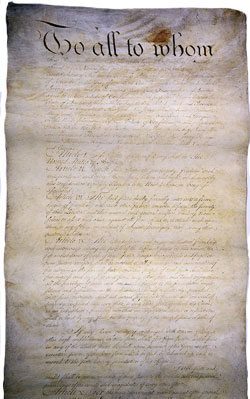The New Government
With the signing of the Treaty of Paris in 1783, Great Britain officially recognized the independence of the United States, while the new nation quickly set about forming a government. Initially it had adopted the Articles of Confederation in 1777.
The Articles of Confederation were a series of laws that were to serve as guidelines in governing the colonies. However, there were some problems with the Articles and in the forming of the new government.
- The Articles of Confederation established a limited national government.
- Under the Articles, there was only one branch of government—a congressional system. This initial congressional system was vastly different from our system of today. There was no financial backing. Congress had to ask individual states for money. It lacked the power needed to enforce any sort of laws or regulations.
- Since there was only one branch of government, there was no main judicial power to enforce laws. Instead, each state maintained its own system of laws and judicial processes.
- Under the Articles, states could send as many representatives from their individual states to participate in Congress as they wished. However, each of the thirteen states had only one vote.
To view the Articles of Confederation, search the Internet or visit your local library.